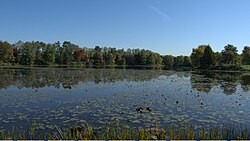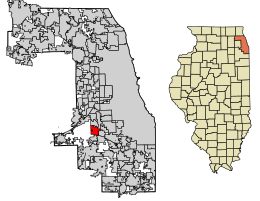Palos Hills, Illinois
Palos Hills, Illinois | |
|---|---|
City | |
| City of Palos Hills | |
 Park in Palos Hills, Illinois | |
| Motto: “Pride In Progress” | |
 Location of Palos Hills in Cook County, Illinois. | |
 Location of Illinois in the United States | |
| Coordinates: 41°41′57″N 87°49′35″W / 41.69917°N 87.82639°W | |
| Country | |
| State | Illinois |
| County | Cook |
| Township | Palos |
| Incorporated | 1958 |
| Government | |
| • Type | Mayor-council |
| • Mayor | Gerald Bennett |
| Area | |
| • Total | 4.29 sq mi (11.11 km2) |
| • Land | 4.25 sq mi (11.00 km2) |
| • Water | 0.04 sq mi (0.11 km2) 0.93% |
| Population (2010) | |
| • Total | 17,484 |
| • Estimate (2016)[2] | 17,410 |
| • Density | 4,100.33/sq mi (1,583.04/km2) |
| Down 1.02% from 2000 | |
| Standard of living (2007-11) | |
| • Per capita income | $29,783 |
| • Median home value | $223,200 |
| ZIP code(s) | 60465 |
| Area code(s) | 708 |
| Geocode | 57394 |
| FIPS code | 17-57394 |
| Website | www |
| Demographics (2010)[3] | |||
|---|---|---|---|
| White | Black | Asian | |
| 88.1% | 5.4% | 2.6% | |
| Islander | Native | Other | Hispanic (any race) |
| 0.02% | 0.2% | 3.7% | 7.4% |
Palos Hills is a city in Cook County, Illinois, United States. It is a southwest suburb of Chicago. The city was established in 1958 and had reached a population of 17,484 in the 2010 census.[3] It is the home of Moraine Valley Community College as well as Amos Alonzo Stagg High School.
Geography
According to the 2010 census, Palos Hills has a total area of 4.292 square miles (11.12 km2), of which 4.25 square miles (11.01 km2) (or 99.02%) is land and 0.042 square miles (0.11 km2) (or 0.98%) is water.[4]
Demographics
| Census | Pop. | Note | %± |
|---|---|---|---|
| 1960 | 3,766 | — | |
| 1970 | 6,629 | 76.0% | |
| 1980 | 16,654 | 151.2% | |
| 1990 | 17,803 | 6.9% | |
| 2000 | 17,665 | −0.8% | |
| 2010 | 17,484 | −1.0% | |
| 2016 (est.) | 17,410 | [2] | −0.4% |
| U.S. Decennial Census[5] | |||
As of the census[6] of 2000, there were 17,665 people, 7,320 households, and 4,772 families residing in the city. The population density was 4,239.7 people per square mile (1,635.6/km²). There were 7,492 housing units at an average density of 1,798.1 per square mile (693.7/km²). The racial makeup of the city was 87.18% White, 5.48% African American, 0.11% Native American, 2.67% Asian, 1.11% Pacific Islander, 1.57% from other races, and 2.98% from two or more races. Hispanic or Latino of any race were 0.83% of the population.
The top five ancestries reported in Palos Hills as of the 2000 census were Irish (19.1%), Polish (18.9%), German (16.3%), Italian (10.5%) and Greek (6.4%).[7]
There were 7,320 households out of which 23.6% had children under the age of 18 living with them, 50.8% were married couples living together, 11.1% had a female householder with no husband present, and 34.8% were non-families. 30.2% of all households were made up of individuals and 11.2% had someone living alone who was 65 years of age or older. The average household size was 2.39 and the average family size was 3.00.
In the city, the population was spread out with 19.0% under the age of 18, 8.8% from 18 to 24, 27.3% from 25 to 44, 27.8% from 45 to 64, and 17.1% who were 65 years of age or older. The median age was 42 years. For every 100 females, there were 88.2 males. For every 100 females age 18 and over, there were 85.4 males.
The median income for a household in the city was $52,164, and the median income for a family was $61,655. Males had a median income of $44,387 versus $32,014 for females. The per capita income for the city was $25,230. About 2.2% of families and 3.5% of the population were below the poverty line, including 4.4% of those under age 18 and 3.4% of those age 65 or over.
Government
Palos Hills is in Illinois' 3rd congressional district.
The mayor is the chief executive while the city council, consisting of ten aldermen elected from five wards, is the legislative body. The Mayor is Gerald R. Bennett. The Clerk is Rudy Mulderink. The Treasurer is Kenneth Nolan.
Aldermen:
- Ward 1: Martin Kleefisch and Joan Knox
- Ward 2: Mark Brachman and Pauline Stratton
- Ward 3: William Hanson and AJ Pasek
- Ward 4: Joseph Marrotta and Ricky Moore
- Ward 5: Mary Ann Schlutz and Frank Williams[8]
North Palos Fire Protection District operates Station 1 and Station 2 in Palos Hills.[9][10]
Education
Elementary school districts serving Palos Hills:
- North Palos School District 117
- Palos School District 118
- All sections are zoned to Palos South Middle School in Palos Park. Currently sections of Palos Hills in District 118 are divided between Palos East Elementary in Palos Heights and Palos West Elementary in Palos Park. Prior to 2016-2017 all of the District 118 portion of Palos Hills was in the Palos East zone.[11]
Amos Alonzo Stagg High School of the Consolidated High School District 230 serves Palos Hills.[12]
Moraine Valley Community College is the area community college.
Notable people
References
- ^ "2016 U.S. Gazetteer Files". United States Census Bureau. Retrieved June 30, 2017.
- ^ a b "Population and Housing Unit Estimates". Retrieved June 9, 2017.
- ^ a b "Profile of General Population and Housing Characteristics: 2010 Demographic Profile Data (DP-1): Palos Hills city, Illinois". U.S. Census Bureau, American Factfinder. Retrieved February 13, 2013.
- ^ "G001 - Geographic Identifiers - 2010 Census Summary File 1". United States Census Bureau. Retrieved December 27, 2015.
- ^ "Census of Population and Housing". Census.gov. Retrieved June 4, 2015.
- ^ "American FactFinder". United States Census Bureau. Retrieved January 31, 2008.
- ^ "Profile of General Demographic Characteristics, Palos Hills, Illinois" (PDF). (38.9 KiB). U.S. Census Bureau. Accessed 2007-04-05.
- ^ "Palos Hills Government Overview". Retrieved July 7, 2012.
- ^ "Station 1." North Palos Fire Protection District. Retrieved on January 20, 2017. "10629 So. Roberts Rd. Palos Hills, IL 60465"
- ^ "Station 2." North Palos Fire Protection District. Retrieved on January 20, 2017. "8913 W. 95th St. Palos Hills, IL 60465"
- ^ "Boundary Change Presentation." Palos School District 118. Retrieved on January 20, 2017. p. 6-8/12.
- ^ "Attendance Areas." Consolidated High School District 230. Retrieved on January 19, 2017.
Further reading
- "History of Palos Hills" (PDF). Published by City of Palos Hills. Retrieved April 21, 2018.


